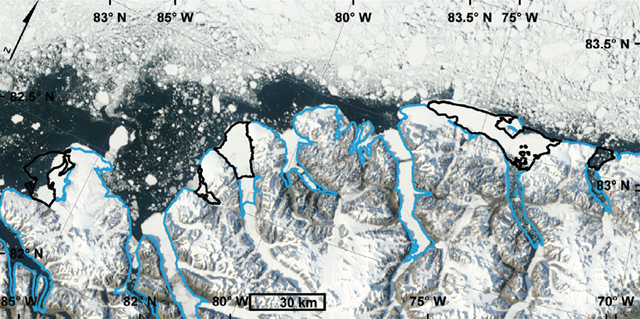Image of the Day: Satellite View of Ellesmere Island Ice Shelf Breakup, August 2008
Ellesmere Island ice shelves at the end of August 2008. The 2007 ice shelf extent is outlined in black and coastline in blue. Left to Right: Serson, Petersen, Milne, and Ward Hunt. The unusually wide expanse of open water along the coast likely contributed to the 2008 break-up of three of these ice shelves. 29 August 2008 MODIS image from the Rapid Response System. The break-up of thick, 40- to 70-year-old multiyear landfast sea ice along the northern coast of Ellesmere Island between 2005 and 2008 (Mueller et al., 2008) has stymied the regeneration of ice shelves that calved during the early to mid-1900s (Evans and England, 1992), and indicates that the Ellesmere ice shelf loss is now irreversible. The loss of multiyear ice that often fringes ice shelf calving fronts and the presence of open water along the coast have also contributed to the recent decline in the Ellesmere ice shelves (Copland et al., 2007). The northern coast of Ellesmere Island has warmed by approximately 2°C since 1948, with most of this increase occurring in the fall and winter (Copland et al., 2007). Under IPCC scenario A1B the Arctic is projected to warm by an additional 5°C with an increase in precipitation of 18% over the next century (Christensen et al., 2007). An increase in winter precipitation is unlikely to reverse this process, although it might slightly retard the average ice shelf surface mass wasting of 6 cm/year (water equivalent) recorded since the 1950s (Braun et al., 2004). Given indications that these ice shelves are currently at or beyond their thermal limit of viability (Copland et al., 2007), it is very likely that they will continue their collapse in the future with reductions in sea ice exacerbating their decline (Mueller et al., 2008; Copland et al., 2010). … Since this text was originally prepared, further losses have occurred, including a further 65-70 km2 from the Ward Hunt Ice Shelf in August 2010 (Sharp and Wolken, 2010). It is difficult to predict when Arctic ice shelves will disappear completely but the extent of loss over the past century is extraordinary. The influence of under-ice processes is not well understood and recent changes in thickness of these ice shelves have not yet been determined.
State of the Arctic Coast 2010 [pdf]
